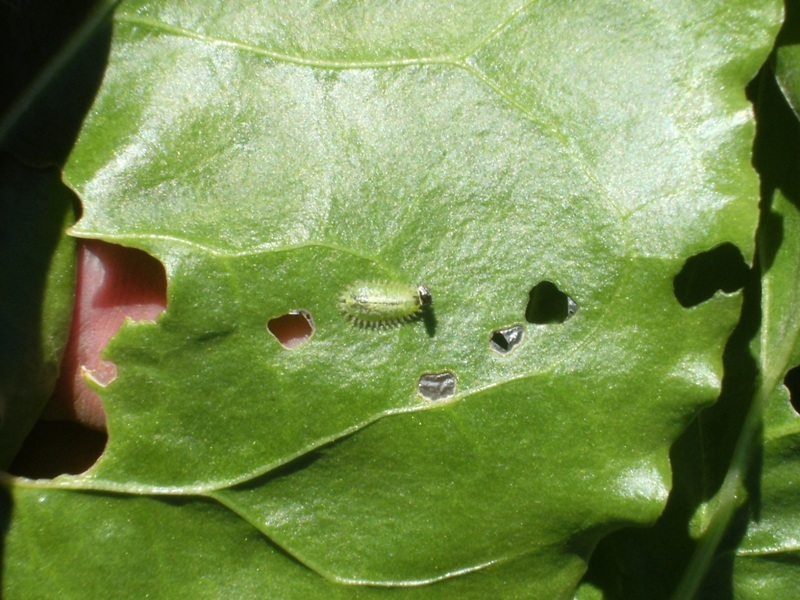
Cassida
Cassida Vittata
Pathogen:
Insect
Type:
Risk:
HIGH






DESCRIPTION
Pathogen description
Cassida vittata, commonly known as the beet cassid, is a beetle insect of the family Chrysomelidae. This insect goes through several stages during its development: egg, larva, pupa and adult. Adults emerge in the spring and begin feeding on sugar beet leaves. Females lay their eggs on the underside of leaves. After hatching, the larvae feed on the leaf tissue, creating galleries and causing significant damage. The larvae go through several molts before pupating in the soil or at the base of plants. After completing the pupal stage, new adults emerge and can continue feeding until the arrival of winter, at which time they seek shelter in the soil or surrounding vegetation to hibernate. The ability of this insect to produce several generations per year and its ability to hibernate allow it to survive in different environmental conditions and represent a constant challenge for crop management.
Disease description
Cassida caused by Cassida vittata severely affects sugar beet, compromising its growth and yield. The damage is mainly foliar, which reduces the photosynthetic capacity of the plant and affects its general development.
- Presence of holes and galleries in the leaves.
- Wearing of the leaf tissue, leaving only the main veins.
- Leaves with a skeletal appearance.
- Decrease in leaf surface useful for photosynthesis.
- Reduction in plant vigor.
- Loss of yield in beet cultivation.
- General weakening of the plant, making it more susceptible to other pests and diseases.

TEMPERATURE AND HUMIDITY
20-30°C
50-70%

VOIES DE TRANSMISSION
Wind, movement of agricultural machinery, infested plants, contaminated soil, transport of plant waste

Chemical treatments
CONTROL
• CYPERMETHRIN 10% [EC] P/V
• CYPERMETHRIN 5% [EC] P/V
• CYPERMETHRIN 50% [EC] P/V
• DELTAMETHRIN 2.5% [EW] P/V
• LAMBDA CYHALOTHRIN 1.5% [CS] P/V
• LAMBDA CYHALOTHRIN 10% [CS] P/V
• LAMBDA CYHALOTHRIN 10% [EC] P/V
• LAMBDA CYHALOTHRIN 2.5% [WG] P/P
Treatments authorized in organic farming
• LAMBDA CYHALOTHRIN 1.5% [CS] P/V
• LAMBDA CYHALOTHRIN 10% [CS] P/V
• LAMBDA CYHALOTHRIN 10% [EC] P/V
• LAMBDA CYHALOTHRIN 2.5% [WG] P/P
Biological control
-
Preventive treatments
-
- Implement an adequate crop rotation to avoid the accumulation of the pest.
- Use sugar beet varieties resistant to Cassida vittata.
- Maintain constant surveillance and carry out regular monitoring of the crop to detect the presence of adults and larvae early.
- Apply specific insecticides in a timely manner, following technical recommendations and respecting withdrawal periods.
- Promote the use of biological control methods, introducing or conserving natural enemies of Cassida vittata, such as parasitoid wasps and natural predators.
- Eliminate crop residues and maintain cleanliness in the field to reduce the pest's hibernation places.
- Implement physical barriers, such as light traps and nets, to reduce adult entry into fields.
- Carry out adequate irrigation and fertilization management to strengthen plants and make them less vulnerable to pest attack.
- Promote crop diversity and the implementation of sustainable agricultural practices that improve the resilience of the agroecosystem.
- Train farmers on the identification and integrated management of pests to ensure a rapid and effective response.
Recommendations
*The recommended treatments are recommendations based on the authorities' databases and do not replace in any way the guidelines established by the legislation of each country.





